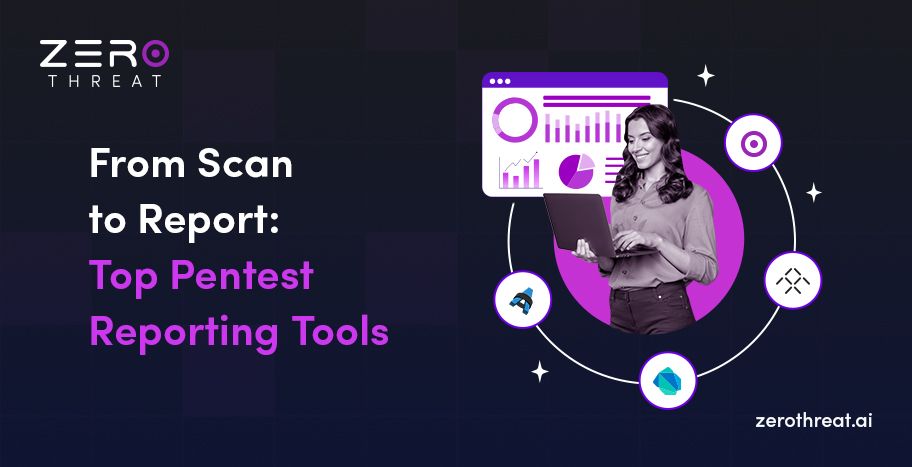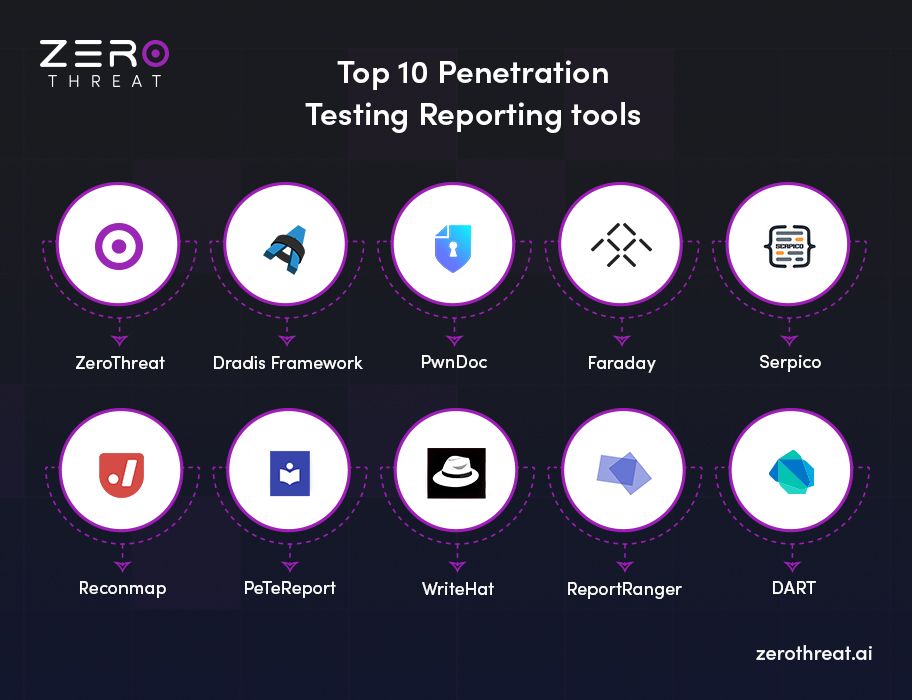All Blogs
Top Pentest Reporting Tools in 2026: From Discovery to Documentation

Quick Overview: Discover the best penetration testing reporting tools that streamline vulnerability tracking, enhance communication, and deliver actionable insights. This blog explores top tools that help security teams document findings effectively, prioritize risks, and simplify compliance—empowering faster, smarter remediation and stronger security postures across modern IT environments.
Penetration testing has emerged as an essential security practice for identifying vulnerabilities in your systems and applications before they can be exploited. But penetration testing is not just about finding security gaps and weaknesses – it’s about how those findings are presented, prioritized, and acted upon. That’s where pentesting reporting tools come into play.
When talking about a pentesting reporting tool, it does more than summarize scan results. It lets you know everything – risks, impacts, and next fixation steps – crafted for both technical teams and business stakeholders. The right tools automate this process, reduce manual efforts, and help security professionals transform findings into actionable insights.
In this blog, we are going to explore top penetration testing reporting tools. We will evaluate them on usability, automation, depth of analysis, and output quality. Whether you are a penetration tester, a developer, or managing enterprise-wide vulnerability assessment, these tools can evaluate your security testing game.
Want Cleaner, Faster Pentest Reports? Connect to Explore ZeroThreat
On This Page
- Why Penetration Testing Reports Matter
- Top Penetration Testing Reporting Tools in 2026
- Wrapping Up
Why Penetration Testing Reports Matter
The value of a penetration test lies not just in identifying vulnerabilities, but in how those vulnerabilities are presented and addressed. A good pentesting report should:
- Offer technical depth for developers and security engineers.
- Provide business context for executives and decision-makers.
- Include compliance with standards like ISO 27001, PCI DSS, HIPAA, and SOC 2.
- Enhance SDLC integration by connecting with CI/CD workflows.
An effective penetration testing report generation tool bridges the gap between discovery and action – converting scan data into risk-based, prioritized, and clear communication.
Top Penetration Testing Reporting Tools in 2026
After understanding the importance of penetration testing, let’s dive into the best tools that are transforming how pen testing results are analyzed, reported, and resolved.

1. ZeroThreat
ZeroThreat is an automated pentest reporting tool that streamlines penetration testing and vulnerability scanning, delivering AI-driven remediation reports. It empowers pentesters and developers to eliminate guesswork with near-zero false positives. Moreover, it allows you to initiate web application scanning in minutes without requiring any technical expertise or complex configuration.
Key Features:
- AI-based Actionable Reports: This free penetration testing reporting tool goes beyond listing issues. Its AI-driven remediation report offers prioritized fixes based on exploitability and business risk.
- Zero False Positives: With an accuracy rate of 98.9%, reports are clean, clear, and confidently actionable.
- Contextual Risk Scoring: Dynamically assigns risk levels with references to CVEs, CVSS scores, and real-world impact.
- Compliance-ready Formats: Export reports tailored for PCI-DSS, ISO 27001, HIPAA, GDPR and more.
- Developer-focused Views: Pinpoints vulnerable code paths and suggests fixes tailored to language and stack.
- CI/CD Integration: Automatically generates vulnerability reports on each deployment pipeline cycle.
Why It Stands Out:
ZeroThreat’s AI ensures that every report is not just a dump of issues but a prioritized roadmap. Whether you’re a CISO looking at executive summaries or a developer diving into stack traces, ZeroThreat adapts the report content for your role.
“We designed ZeroThreat to transform security reporting from a manual, error-prone process into a smart, automated conversation between tech and business.” says Dharmesh Acharya, Co-founder of ZeroThreat.
Best For:
Security teams who want end-to-end visibility from testing to remediation, especially in fast-moving CI/CD environments.
2. Dradis Framework
Dradis is an open-source collaboration and reporting tool tailored for penetration testers. It’s not a scanner itself but works with output from tools like Nessus, Burp Suite, and Nmap to generate structured reports.
Key Features:
- Consolidates results from multiple tools into a single report.
- Offers custom templates in formats like Word, PDF, or HTML.
- Enables team collaboration and annotation.
- Includes a centralized vulnerability library for consistency.
Why It Stands Out:
Dradis acts as a reporting engine for manual and automated tools alike. It’s ideal for consultancies or red teams who use multiple tools and want to normalize outputs into one clean document.
Best For:
Penetration testers and security consultants who manage reports across multiple projects and tools.
3. PwnDoc
PwnDoc is a free and open-source tool that provides a modern, web-based interface for automated penetration test reporting. It allows testers to write, manage, and export professional-looking reports without the traditional headache of Word docs.
Key Features:
- Web-based collaborative interface.
- Customizable report templates.
- Markdown support for rich formatting.
- Centralized vulnerability database.
- PDF export with branding support.
Why It Stands Out:
PwnDoc is clean, intuitive, and collaborative—helping teams produce client-ready reports quickly while allowing consistent formatting and content reuse.
Best For:
Penetration testers and agencies delivering structured and client-facing vulnerability reports.
4. Faraday
Faraday is a collaborative penetration testing environment built to distribute, organize, and analyze data generated during security audits. Its core goal is to leverage existing community tools and enhance their usefulness in a multiuser setting.
Faraday is a comprehensive collaborative platform for managing vulnerability assessments. It combines scanning, reporting, and project management into a single environment.
Key Features:
- Aggregates results from 80+ security tools.
- Real-time dashboard views and customizable widgets.
- Automatic ticket generation for remediation.
- Supports compliance audits and custom reporting.
Why It Stands Out:
Faraday helps teams transition from raw scan data to team collaboration and ticket-based resolution, making it a great choice for internal security teams in larger organizations.
Best For:
Enterprise security operations that require centralized vulnerability lifecycle management.
Automate Your Pentest Documentation and Free Up Valuable Hours Get Started with Automation
5. Serpico
Serpico (SimplE RePort wrIting and CollaboratiOn) is another open-source tool designed to help penetration testers create consistent, high-quality reports. It was built to automate the labor-intensive process of vulnerability documentation. It helps security experts create detailed information security and penetration testing reports.
Key Features:
- Templating system for reusing report content.
- Integration with standard scanning tools.
- Custom metadata fields for sorting and filtering.
- HTML and PDF export with branding.
Why It Stands Out:
Serpico helps reduce the repetitive nature of pen test reporting while enforcing consistency and quality.
Best For:
Red teams and freelance security auditors focused on professional-looking, templated reporting.
6. Reconmap
Reconmap is a penetration testing platform that combines task management, reporting, and collaboration. It's designed to help penetration testers track engagements and manage documentation across a full engagement lifecycle.
Key Features:
- Built-in vulnerability and task tracking.
- Markdown editor for reporting.
- Custom report templates.
- PDF exports with automated data population.
Why It Stands Out:
It’s a hybrid between a project management tool and a reporting engine—perfect for keeping engagements organized from planning to delivery.
Best For:
Penetration testers looking for an end-to-end platform to manage test engagements and deliverables.
7. PeTeReport
PeTeReport is a Python-based, open-source tool built specifically for penetration testers to manage and generate reports. It provides a simple web interface to track findings and export detailed documents.
Key Features:
- Web-based interface for adding findings and assets.
- Automated LaTeX/PDF report generation with clean formatting.
- Markdown support for flexible input.
- Customizable templates for different clients or engagement types.
Why It Stands Out:
It’s easy to set up, fast to use, and gives pentesters a repeatable structure without vendor lock-in.
Best For:
Independent testers and security teams looking for quick, elegant report generation with minimal overhead.
8. WriteHat
WriteHat is a lightweight, team-friendly reporting tool that uses Markdown and Git to organize and version pentest reports. It supports asynchronous collaboration and version-controlled editing.
Key Features:
- Markdown-based findings management.
- Git integration for version tracking and collaboration.
- Tagging and filtering by severity, asset, or status.
- Export to HTML and PDF with templates.
Why It Stands Out:
WriteHat is perfect for distributed teams or consultants who want to collaborate and track changes without clunky UIs or licensing hurdles.
Best For:
Freelancers, remote red teams, or consultancies that value version control and Markdown simplicity.
9. ReportRanger
ReportRanger is a GUI tool for managing pentest findings in a structured format. It emphasizes reusable data (like proof-of-concept code, evidence screenshots, and descriptions) and streamlined PDF export.
Key Features:
- Drag-and-drop interface for organizing findings.
- Vulnerability library reuse across multiple reports.
- Attachment and screenshot support for proof documentation.
- Export to PDF with customizable branding.
Why It Stands Out:
ReportRanger is a presentation-focused tool that helps pentesters build client-ready reports with visual polish and consistency.
Best For:
Consultants and service providers who want clean, branded reports for non-technical stakeholders.
10. DART
DART (Documentation and Reporting Tool) is a modular, API-driven platform for security testing documentation. It’s designed to integrate with scanning tools and enable automation of report generation.
Key Features:
- REST API for report creation and automation.
- Support for custom templates and JSON data ingestion.
- Engagement tracking, timelines, and evidence in structured form.
- Export to DOCX and PDF formats.
Why It Stands Out:
DART is designed with automation in mind—great for larger teams or platforms that want to plug reporting into an existing DevSecOps pipeline.
Best For:
Mature security teams or platforms needing scalable, API-driven reporting with CI/CD integration potential.
Level Up with ZeroThreat That Make Pentest Results Easier to Understand and Act On Get Your Report in Minutes
Wrapping Up
There are numerous tools available in the market that help you find vulnerabilities – but tools that help you communicate them effectively are what truly bridge the gap between discovery and protection.
Whether you are delivering to a boardroom or a dev team, ZeroThreat’s pentesing tool ensures your findings are clear, prioritized, and actionable.
Choose tools based on:
- Team size and structure (solo consultant vs enterprise red team).
- Level of automation needed (manual vs API-first).
- Audience (technical, compliance, executive).
- Integration requirements (CI/CD pipelines, version control, templates).
Want faster, smarter pentest reporting that fits your CI/CD workflow? Contact us to know more about ZeroThreat and learn how its AI-powered reports help your development team fix faster—before attackers strike.
Frequently Asked Questions
What is a penetration testing reporting tool?
A penetration testing reporting tool is an application that helps you penetrate real-world attacks on networks, applications, or systems and generate comprehensive reports of simulated attacks. These reports entail detailed vulnerability attacks along with their potential impact and recommended remediation steps.
Why is reporting important in penetration testing?
What features should a good pentest reporting tool include?
Can penetration testing reports be automated?
Are there tools that provide both scanning and reporting in one platform?
How do pentest reporting tools support compliance?
What format should a professional pentest report follow?
Are there free tools that generate pentesting reports?
Explore ZeroThreat
Automate security testing, save time, and avoid the pitfalls of manual work with ZeroThreat.



